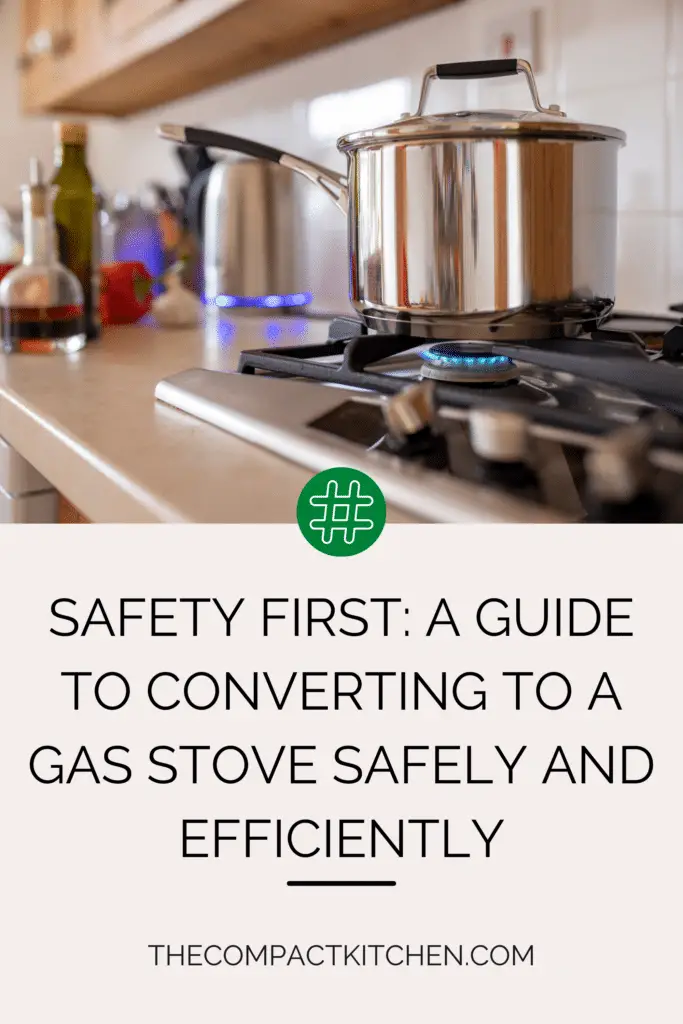Hey there! Ever thought about switching to a gas stove in your kitchen? It’s a big decision, but don’t worry – I’ve got you covered! In this blog post, we’ll dive into everything you need to know about gas stoves – from understanding the basics and advantages to safety measures and crucial considerations. So, grab a cup of coffee and let’s get started on your journey to a safer and more efficient cooking experience with a gas stove!

Understanding the Basics of Gas Stoves
Gas stoves are a popular choice for many homeowners due to their efficiency and precision in cooking. Before you consider converting to a gas stove, it’s important to understand the basics of how they operate and what sets them apart from electric ovens and other types of stoves.
Distinguishing Gas Stoves

Gas stoves rely on natural gas or propane as a fuel source to produce a flame that heats the cooking surface. This allows for instant heat and precise temperature control which is favored by many professional chefs. In contrast, electric ovens use electricity to generate heat through coils or heating elements.
Crucial Components and Operations
A gas stove consists of several essential components such as burners, grates, knobs, and a gas line connection. When the burner is turned on, gas is released and ignited to create a flame. It’s important to ensure proper ventilation to prevent the accumulation of gas fumes in the kitchen.
Understanding how a gas stove operates can help you make an informed decision when considering a switch from an electric stove. The instant heat and precise control offered by gas stoves can greatly enhance your cooking experience, but it’s crucial to prioritize safety considerations when making the transition.
The Advantages and Disadvantages of Gas Stoves
Gas stoves have been a popular choice for cooking for many years, and for good reason. They offer a variety of benefits that can make cooking a more enjoyable experience. However, like any appliance, there are also drawbacks to consider when thinking about converting to a gas stove. Let’s take a closer look at the advantages and disadvantages of gas stoves.
Advantages of Gas Stoves
One of the main advantages of gas stoves is the increase in property value. Many homebuyers prefer gas stoves over electric ones, so converting to a gas stove can actually boost the resale value of your home. Additionally, gas stoves are known for their cost-effectiveness. Gas is often cheaper than electricity, so using a gas stove can help you save money on your utility bills.

Gas stoves also heat up much faster than electric stoves, which can save you time in the kitchen. This quick heating feature is especially useful when you’re in a rush to get dinner on the table. Another advantage of gas stoves is the precise heat control they offer. With a gas stove, you can easily adjust the flame to get the perfect temperature for your cooking needs.
Disadvantages of Gas Stoves
While there are many advantages to using a gas stove, there are also some drawbacks to consider. One of the biggest concerns with gas stoves is the risk of gas leaks. Gas leaks can be extremely dangerous and can lead to fires or explosions if not addressed quickly. It’s important to properly maintain your gas stove and be on the lookout for any signs of a gas leak.

Another disadvantage of gas stoves is the potential for accidents. Because gas stoves use an open flame, there is a higher risk of burns or fires if proper precautions are not taken. It’s crucial to follow safety measures when using a gas stove and to be vigilant about any potential hazards.

In conclusion, gas stoves offer a variety of advantages such as increase in property value, cost-effectiveness, fast heating, and precise heat control. However, it’s important to be aware of the potential drawbacks including the risk of gas leaks and accidents. By understanding the benefits and challenges of gas stoves, you can make an informed decision about whether converting to a gas stove is the right choice for you.
Safety Measures in Using a Gas Stove
When it comes to using a gas stove in your home, safety should always be your top priority. Gas stoves can provide many benefits, but they also come with potential risks if not used and maintained properly. In this section, we will discuss some essential safety measures to ensure a safe and worry-free experience with your gas stove.
Regular Maintenance
One of the key safety measures when using a gas stove is regular maintenance. It is crucial to have your gas stove inspected and serviced by a professional at least once a year to ensure that all components are functioning correctly. Regular maintenance can help detect any potential issues early on, preventing accidents and ensuring the longevity of your gas stove.
Quick Response to Irregularities

Another important safety measure is to always be vigilant and respond quickly to any irregularities with your gas stove. If you notice any strange smells, hissing sounds, or malfunctioning components, it is essential to turn off the gas supply immediately and contact a professional for assistance. Ignoring these signs can lead to gas leaks or other hazardous situations.
Proper Usage
Proper usage of a gas stove is also crucial for ensuring safety. Always follow the manufacturer’s instructions for operating the stove, including how to light the burners and adjust the heat settings. Make sure to keep flammable items away from the stove, and never leave it unattended while in use. By following these basic guidelines, you can significantly reduce the risk of accidents or injuries.
Installing a Carbon Monoxide Detector
One safety measure that is often overlooked but incredibly important is installing a carbon monoxide detector near your gas stove. Carbon monoxide is a colorless, odorless gas that can be produced by gas stoves and other appliances, and exposure to high levels can be deadly. A carbon monoxide detector can alert you to any dangerous levels of this gas in your home, allowing you to take action and prevent illness or injury.

In conclusion, prioritizing safety when using a gas stove is essential to protect yourself and your family from potential hazards. By following these safety measures, including regular maintenance, quick response to irregularities, proper usage, and installing a carbon monoxide detector, you can enjoy all the benefits of a gas stove while minimizing the risks. Remember, safety always comes first when it comes to gas stove use.
Steps in Converting to a Gas Stove
Making the switch from an electric stove to a gas stove can be a significant decision for homeowners. Not only does it offer benefits like faster heating and precise heat control, but it also requires careful consideration of safety measures. Here, we’ll walk you through the essential steps in converting to a gas stove and highlight crucial precautionary steps during the process.
Contacting Professionals
The first step in converting to a gas stove is to contact professionals for guidance. While some DIY enthusiasts may be tempted to tackle the conversion process themselves, it’s crucial to consult with experts to ensure a safe and smooth transition. Professionals can assess your current setup, offer advice on the best gas stove options, and provide an estimate of the overall cost.

When selecting professionals for the installation, be sure to choose certified technicians with experience in gas stove conversions. They should be knowledgeable about safety precautions, local building codes, and proper installation techniques to prevent any hazards in your home.
Installation and Proper Set-Up
Once you’ve consulted with professionals and chosen the right gas stove for your kitchen, the next step is installation and proper set-up. This process involves removing the existing electric stove, making necessary adjustments to the gas lines, and installing the new appliance according to manufacturer instructions.
During installation, it’s essential to follow safety protocols to prevent gas leaks, fire hazards, and other risks. All connections should be securely tightened and checked for leaks using a specialized solution. Proper ventilation is also crucial to ensure that any gas fumes are safely expelled from your home.
Proper set-up includes adjusting the gas stove’s burners for optimal performance and efficiency. Technicians may need to calibrate the burners to ensure even heat distribution and prevent potential issues like gas buildup or uneven cooking.
Highlighting Precautionary Steps
Throughout the conversion process, it’s important to highlight precautionary steps to maintain gas stove safety. This includes keeping flammable materials away from the stove, ensuring proper ventilation in the kitchen, and regularly inspecting and maintaining the gas stove components.
Additionally, homeowners should be aware of warning signs of gas leaks, such as hissing sounds, foul odors, or inaccurate burner flames. If any irregularities are detected, it’s crucial to turn off the gas supply immediately and contact a professional for inspection and repairs.
By following these steps in converting to a gas stove and prioritizing safety precautions, homeowners can enjoy the benefits of gas cooking while minimizing potential risks. Remember, safety should always be the top priority when making the switch to a gas stove in your home.
Essential Considerations When Making the Switch
So, you’ve decided to make the switch from an electric stove to a gas stove. Congratulations on taking this step towards a more efficient and precise cooking experience! However, before you dive into the conversion process, there are some essential considerations you need to keep in mind to ensure a smooth and safe transition.
Cost
One of the first things to consider when converting to a gas stove is the cost. While gas stoves are known for their cost-effectiveness in the long run, the initial investment can be higher than that of an electric stove. You will need to factor in the cost of the stove itself, installation fees, as well as any additional equipment or upgrades required for a successful conversion.
Space
Another crucial consideration is the space in your kitchen. Gas stoves generally require more room than electric stoves, particularly for ventilation purposes. Make sure you have enough space for the stove, as well as proper airflow to prevent any safety hazards. Consider the layout of your kitchen and plan accordingly to accommodate the new appliance.
Ventilation
Proper ventilation is vital when it comes to gas stoves. Unlike electric stoves, gas stoves produce combustion byproducts that need to be safely vented out of your home. Ensure that your kitchen has adequate ventilation to prevent the buildup of harmful gases like carbon monoxide. If needed, consider installing a range hood or exhaust fan to improve air circulation.
Ordinance Compliance
Before making the switch to a gas stove, check local ordinances and building codes to ensure compliance with safety regulations. Some areas may have specific requirements for gas appliance installations to prevent accidents and ensure the well-being of residents. It’s always better to be safe than sorry, so make sure you are following the proper guidelines before converting to a gas stove.
Stay Safe While Cooking with Gas!
As you embark on the journey of converting to a gas stove, remember safety always comes first. Keep in mind the importance of regular maintenance, quick responses to issues, and installing a carbon monoxide detector. Prioritize safety measures before, during, and after making the switch to ensure a smooth and secure cooking experience. Happy cooking and stay safe! 🍳🔥 #GasStoveSafetyTips








